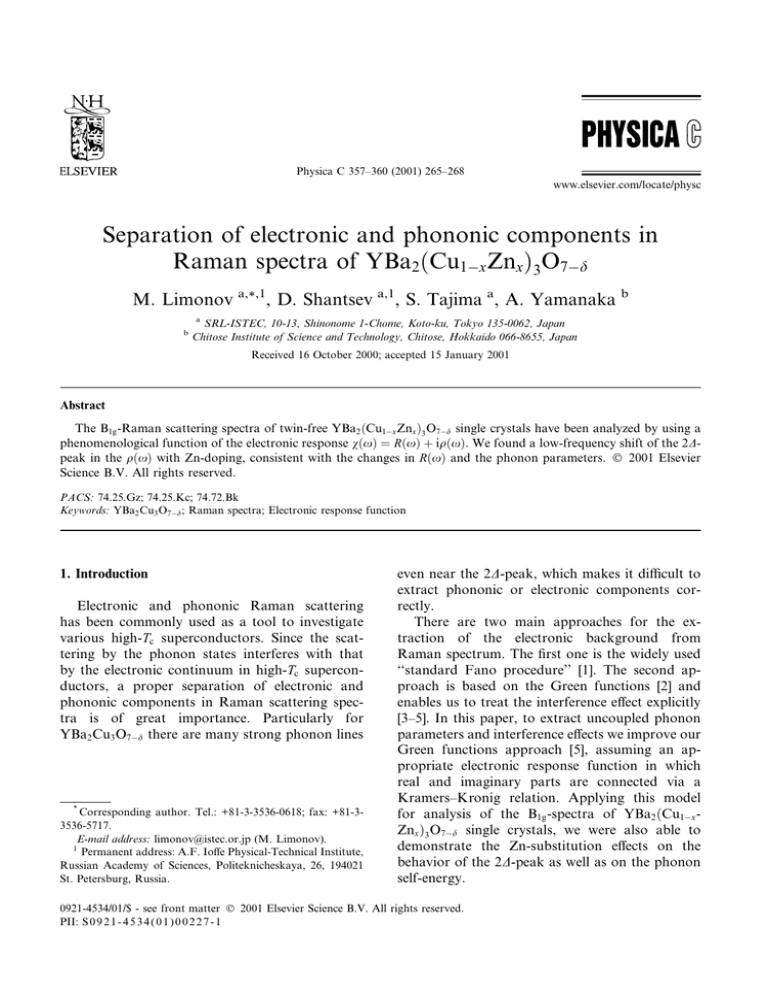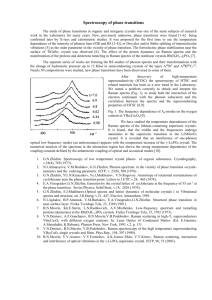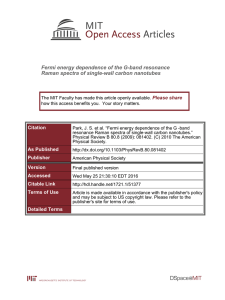Separation of electronic and phononic components in Raman spectra of YBa Cu Zn
advertisement

Physica C 357±360 (2001) 265±268 www.elsevier.com/locate/physc Separation of electronic and phononic components in Raman spectra of YBa2 Cu1 x Znx 3O7 d M. Limonov a,*,1, D. Shantsev a,1, S. Tajima a, A. Yamanaka b b a SRL-ISTEC, 10-13, Shinonome 1-Chome, Koto-ku, Tokyo 135-0062, Japan Chitose Institute of Science and Technology, Chitose, Hokkaido 066-8655, Japan Received 16 October 2000; accepted 15 January 2001 Abstract The B1g -Raman scattering spectra of twin-free YBa2 Cu1 x Znx 3 O7 d single crystals have been analyzed by using a phenomenological function of the electronic response v x R x iq x. We found a low-frequency shift of the 2Dpeak in the q x with Zn-doping, consistent with the changes in R x and the phonon parameters. Ó 2001 Elsevier Science B.V. All rights reserved. PACS: 74.25.Gz; 74.25.Kc; 74.72.Bk Keywords: YBa2 Cu3 O7 d ; Raman spectra; Electronic response function 1. Introduction Electronic and phononic Raman scattering has been commonly used as a tool to investigate various high-Tc superconductors. Since the scattering by the phonon states interferes with that by the electronic continuum in high-Tc superconductors, a proper separation of electronic and phononic components in Raman scattering spectra is of great importance. Particularly for YBa2 Cu3 O7 d there are many strong phonon lines * Corresponding author. Tel.: +81-3-3536-0618; fax: +81-33536-5717. E-mail address: limonov@istec.or.jp (M. Limonov). 1 Permanent address: A.F. Ioe Physical-Technical Institute, Russian Academy of Sciences, Politeknicheskaya, 26, 194021 St. Petersburg, Russia. even near the 2D-peak, which makes it dicult to extract phononic or electronic components correctly. There are two main approaches for the extraction of the electronic background from Raman spectrum. The ®rst one is the widely used ``standard Fano procedure'' [1]. The second approach is based on the Green functions [2] and enables us to treat the interference eect explicitly [3±5]. In this paper, to extract uncoupled phonon parameters and interference eects we improve our Green functions approach [5], assuming an appropriate electronic response function in which real and imaginary parts are connected via a Kramers±Kronig relation. Applying this model for analysis of the B1g -spectra of YBa2 Cu1 x Znx 3 O7 d single crystals, we were also able to demonstrate the Zn-substitution eects on the behavior of the 2D-peak as well as on the phonon self-energy. 0921-4534/01/$ - see front matter Ó 2001 Elsevier Science B.V. All rights reserved. PII: S 0 9 2 1 - 4 5 3 4 ( 0 1 ) 0 0 2 2 7 - 1 266 M. Limonov et al. / Physica C 357±360 (2001) 265±268 2. Results and discussion In this paper, precise temperature dependences of the Raman spectra have been investigated for optimally doped twin-free YBa2 Cu1 x Znx 3 O7 d single crystals. These crystals were grown by a topseeded pulling technique and oxygenated under uniaxial pressure in order to obtain the orthorhombic twin-free samples as described previously [6]. The Zn-free crystal show the maximum Tc of 93 K, while it decreases down to 85 K in the 0.4% Zn-doped sample with optimal oxygen content. The Raman spectra were studied using a T64000 Jobin±Ivon triple spectrometer with a liquidnitrogen cooled CCD detector. A typical spectral resolution was 3 cm 1 . The 514.5 nm line of an Ar±Kr laser was used for the excitation. The power density was about 1 W/cm2 on the sample surface, and, as a result, the overheating was suppressed down to less than 5 K in all experiments. The Raman spectra in the X 0 Y 0 -polarization (B1g symmetry in a tetragonal D4h notation) consist of electronic continuum and the B1g -like phonon line at about 340 cm 1 . Additionally, several weak A1g -like phonon lines appear in the spectra. Fig. 1 shows an example of the X 0 Y 0 -spectra for the YBa2 Cu0:996 Zn0:004 3 O7 d crystal after subtraction of all A1g -like phonons. This subtraction was performed using A1g -like Raman spectra (XX- and YY-polarizations) from our previous paper [7]. Below Tc the electronic spectrum exhibits a superconducting response with a broad 2D-peak. To extract the phononic and electronic parameters correctly, we use formula obtained on a basis of the Green's function approach for description of the coupled electron±phonon Raman spectrum [2]: 1 F x B x q x C 1 e2 2 S 2 2 xV 2q xeS q ; 1 V2 where B x 1 n x; T is the Bose factor, e x X=C, S S0 V 2 R x. The renormalized frequency X and the line width C of the phonon are represented as X X0 V 2 R x and C C0 V 2 q x, where V is the electron±phonon cou- Fig. 1. The Raman spectra of the YBa2 Cu0:996 Zn0:004 3 O7 d crystal at T 10 K in the X 0 Y 0 -polarization after subtraction of A1g -like phonons. The thick solid curve is the results of the ®tting procedure using Eq. (1). The thin solid curve shows q x function. In the inset both real and imaginary parts of the electronic response v x R x iq x are presented. pling constant, X0 and C0 are uncoupled values, q x and R x are the imaginary and real parts of the electronic response v x. Four parameters X0 , C0 , S0 , and V were set x-independent in the ®tting. The key point of the present treatment is a proper description of the electronic response function v x R x iq x. In the paper by Bock et al. [3], the phenomenological expression I1 tanh x=xT was proposed to describe the incoherent electronic background. We examined several another formulae for qn x, and the good ®tting was obtained with the following expression: x qn x Cn p ; 2 x2 x2T where Cn and xT are the ®tting parameters. This function ®ts successfully the conventional behavior of the normal electronic response function, i.e. q x ! const at high frequencies and q x / x at low x. The real part R x is directly linked to the imaginary part q x via the Kramers±Kronig relation. For a certain cuto frequency xcut (xcut X) for qn x, Hilbert transformation of Eq. (2) gives M. Limonov et al. / Physica C 357±360 (2001) 265±268 2 267 For temperatures below Tc , it is convenient to write down the total electronic response as a sum of the normal and superconducting contributions, q x qn x qs x. The superconducting contribution qs x should re¯ect the appearance of the superconducting gap leading to a 2D-peak which is accompanied by a suppression of q x at lower frequencies. Both the peak and the suppression are described by Lorentzians with opposite signs similar to those proposed in Ref. [3]. As can be seen in Fig. 1, the ®tting of the experimental Raman spectrum is perfect. To extract the Zn-doping dependence of the superconducting gap, we investigated the temperature dependence of the electronic response function q x. We have found a pronounced low-frequency shift of the peak in q x with Zn-doping (Fig. 2). This result suggests that the gap amplitude D T 0 de- creases by 30 cm 1 owing to a small amount of Zn-doping (x 0:4%). Although in¯uence of Zn-doping on the Raman scattering of YBa2 Cu1 x Znx 3 O7 d single crystals have been investigated before [8], such a decrease of the gap energy in B1g -polarization was not reported in Ref. [8] probably because the spectra were analyzed simply by mutual subtraction without taking into account any interference eect. The ®tting procedure taking into account both q x and R x explicitly, also allows us to extract the uncoupled phonon parameters X0 , C0 , and S0 . A complete picture of Raman scattering in the YBa2 Cu1 x Znx 3 O7 d crystals will be discussed in a separate paper [9]. As an example, the temperature dependences of both uncoupled X0 and renormalized X X0 V 2 R frequencies of the 340 cm 1 line are shown in Fig. 3. The uncoupled frequencies X0 show a smooth temperature dependence, without any anomaly in the superconducting state. Even in the normal state, we can see a small softening (V 2 R 2 cm 1 ) of renormalized frequencies X due to interaction with the electronic background. The superconductivity induced eect manifests itself in a rapid decrease of the renormalized frequencies below Tc . The magnitude of softening of the 340 cm 1 line in the Zn-free Fig. 2. The temperature dependences of the maximums of the electronic response functions q x in the X 0 Y 0 -polarization for the pure and Zn-doped YBa2 Cu1 x Znx 3 O7 d crystals. The solid lines are guides to the eye. Fig. 3. Temperature dependences of the uncoupled X0 and renormalized X X0 V 2 R frequencies of the 340 cm 1 phonon line for the Zn-free and Zn-doped YBa2 Cu1 x Znx 3 O7 d single crystals. R x p x2T x2cut xcut Cn 6 x p 4 ln p p x2T x2cut xcut x2 x2T 0 13 q 2 2 2 2 x2 x xx x x x cut T T T cut x x B cut C7 q ln @ A5 : xcut x x2 xx x2T x2cut x2 x2T cut T 3 268 M. Limonov et al. / Physica C 357±360 (2001) 265±268 and Zn-doped YBa2 Cu1 x Znx 3 O7 d crystals is essentially dierent, re¯ecting a dierence in R x between the two crystals. Acknowledgements The authors are thankful to A.I. Rykov for preparation of the samples and to J. Quilty for helpful discussions. This work is supported by New Energy and Industrial Technology Development Organization (NEDO) as Collaborative Research and Development of Fundamental Technologies for Superconductivity Applications. One of us (DS) was supported by STA fellowship. References [1] U. Fano, Phys. Rev. 124 (1961) 1866. [2] X.K. Chen, E. Altendorf, J.C. Irwin, R. Liang, W.N. Hardy, Phys. Rev. B 48 (1993) 10530. [3] A. Bock, S. Ostertun, R. Das Sharma, M. R ubhausen, K.-O. Subke, C.T. Rieck, Phys. Rev. B 60 (1999) 3532. [4] A. Bock, Annalen der Physik 8 (1999) 441. [5] M.F. Limonov, A.I. Rykov, S. Tajima, A. Yamanaka, Phys. Rev. B 61 (2000) 12412. [6] A.I. Rykov, W.J. Jang, H. Unoki, S. Tajima, in: H. Hayakawa, Y. Enomoto (Eds.), Advances in Superconductivity VIII, Springer, Tokyo, 1996, pp. 341±344. [7] M.F. Limonov, S. Tajima, A. Yamanaka, in: T. Yamashita, K. Tanabe (Eds.), Advances in Superconductivity XII, Springer, Tokyo, 2000, pp. 269±271. [8] A. Matic, M. Kall, L. B orjesson, Y. Eltsev, J. Phys. Chem. Solids 56 (1995) 1835. [9] M. Limonov, D. Shantsev, S. Tajima, A. Yamanaka, in press.








